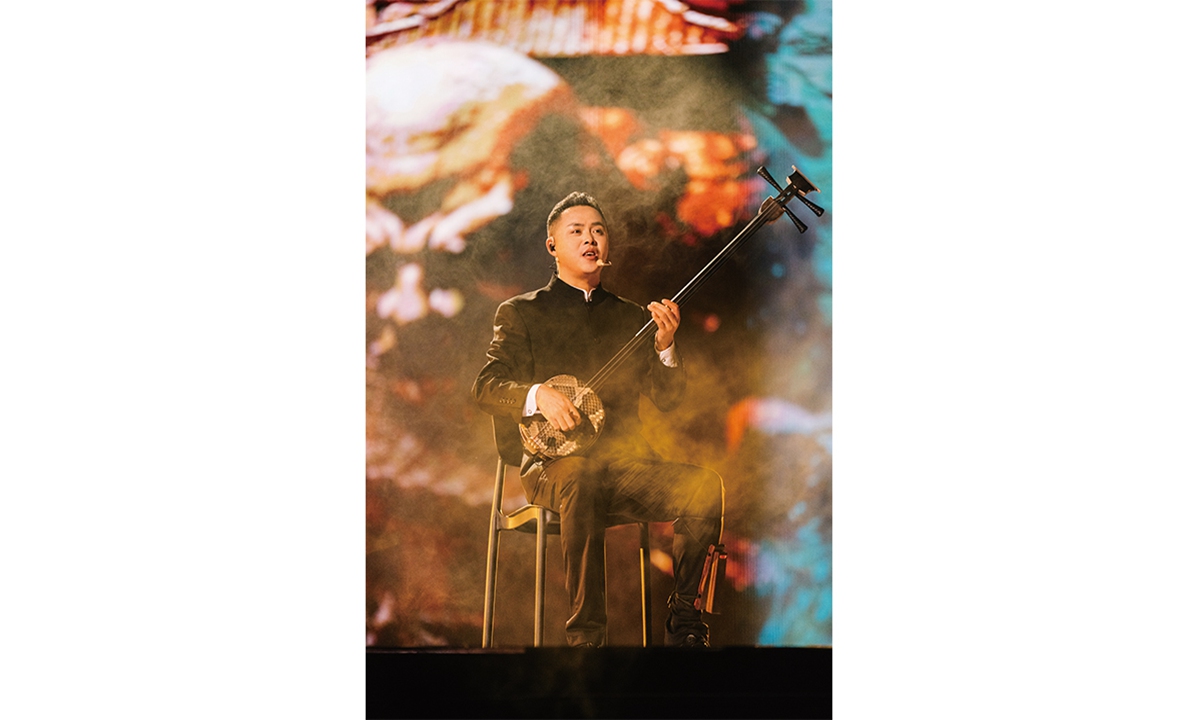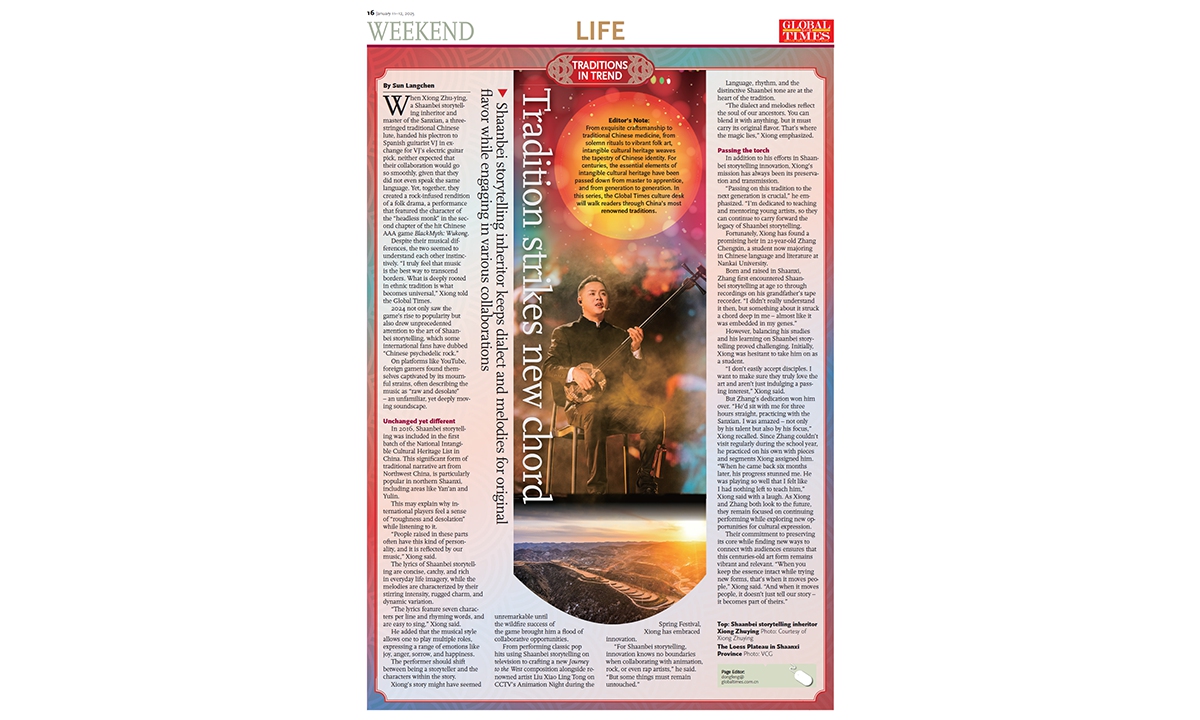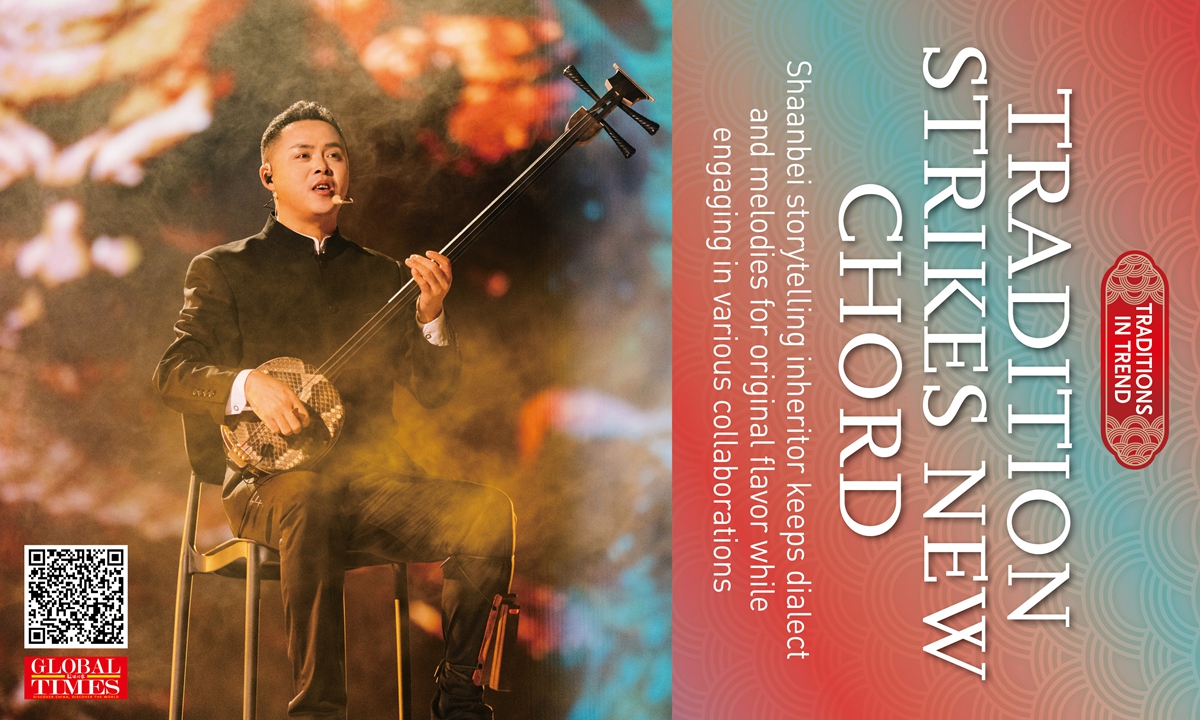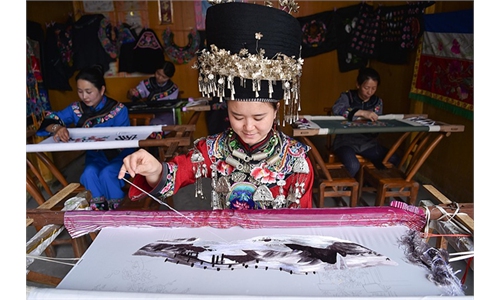ARTS / CULTURE & LEISURE
Shaanbei storytelling inheritor keeps dialect and melodies for original flavor while engaging in various collaborations
Editor's Note:
From exquisite craftsmanship to traditional Chinese medicine, from solemn rituals to vibrant folk art, intangible cultural heritage weaves the tapestry of Chinese identity. For centuries, the essential elements of intangible cultural heritage have been passed down from master to apprentice, and from generation to generation. In this series, the Global Times culture desk will walk readers through China's most renowned traditions.

Despite their musical differences, the two seemed to understand each other instinctively. "I truly feel that music is the best way to transcend borders. What is deeply rooted in ethnic tradition is what becomes universal," Xiong told the Global Times.
2024 not only saw the game's rise to popularity but also drew unprecedented attention to the art of Shaanbei storytelling, which some international fans have dubbed "Chinese psychedelic rock."
On platforms like YouTube, foreign gamers found themselves captivated by its mournful strains, often describing the music as "raw and desolate" - an unfamiliar, yet deeply moving soundscape.
Unchanged yet different
In 2016, Shaanbei storytelling was included in the first batch of the National Intangible Cultural Heritage List in China. This significant form of traditional narrative art from Northwest China, is particularly popular in northern Shaanxi, including areas like Yan'an and Yulin.
This may explain why international players feel a sense of "roughness and desolation" while listening to it.
"People raised in these parts often have this kind of personality, and it is reflected by our music," Xiong said.
The lyrics of Shaanbei storytelling are concise, catchy, and rich in everyday life imagery, while the melodies are characterized by their stirring intensity, rugged charm, and dynamic variation.
"The lyrics feature seven characters per line and rhyming words, and are easy to sing," Xiong said.
He added that the musical style allows one to play multiple roles, expressing a range of emotions like joy, anger, sorrow, and happiness.
The performer should shift between being a storyteller and the characters within the story.
Xiong's story might have seemed unremarkable until the wildfire success of the game brought him a flood of collaborative opportunities.
From performing classic pop hits using Shaanbei storytelling on television to crafting a new Journey to the West composition alongside renowned artist Liu Xiao Ling Tong on CCTV's Animation Night during the Spring Festival, Xiong has embraced innovation.
"For Shaanbei storytelling, innovation knows no boundaries when collaborating with animation, rock, or even rap artists," he said. "But some things must remain untouched."
Language, rhythm, and the distinctive Shaanbei tone are at the heart of the tradition.
"The dialect and melodies reflect the soul of our ancestors. You can blend it with anything, but it must carry its original flavor. That's where the magic lies," Xiong emphasized.

In addition to his efforts in Shaanbei storytelling innovation, Xiong's mission has always been its preservation and transmission.
"Passing on this tradition to the next generation is crucial," he emphasized. "I'm dedicated to teaching and mentoring young artists, so they can continue to carry forward the legacy of Shaanbei storytelling.
Fortunately, Xiong has found a promising heir in 21-year-old Zhang Chengxin, a student now majoring in Chinese language and literature at Nankai University.
Born and raised in Shaanxi, Zhang first encountered Shaanbei storytelling at age 10 through recordings on his grandfather's tape recorder. "I didn't really understand it then, but something about it struck a chord deep in me - almost like it was embedded in my genes."
However, balancing his studies and his learning on Shaanbei storytelling proved challenging. Initially, Xiong was hesitant to take him on as a student.
"I don't easily accept disciples. I want to make sure they truly love the art and aren't just indulging a passing interest," Xiong said.
But Zhang's dedication won him over. "He'd sit with me for three hours straight, practicing with the Sanxian. I was amazed - not only by his talent but also by his focus," Xiong recalled. Since Zhang couldn't visit regularly during the school year, he practiced on his own with pieces and segments Xiong assigned him. "When he came back six months later, his progress stunned me. He was playing so well that I felt like I had nothing left to teach him," Xiong said with a laugh. As Xiong and Zhang both look to the future, they remain focused on continuing performing while exploring new opportunities for cultural expression.
Their commitment to preserving its core while finding new ways to connect with audiences ensures that this centuries-old art form remains vibrant and relevant. "When you keep the essence intact while trying new forms, that's when it moves people," Xiong said. "And when it moves people, it doesn't just tell our story - it becomes part of theirs."


From exquisite craftsmanship to traditional Chinese medicine, from solemn rituals to vibrant folk art, intangible cultural heritage weaves the tapestry of Chinese identity. For centuries, the essential elements of intangible cultural heritage have been passed down from master to apprentice, and from generation to generation. In this series, the Global Times culture desk will walk readers through China's most renowned traditions.

Shaanbei storytelling inheritor Xiong Zhuying Photo: Courtesy of Xiong Zhuying
When Xiong Zhu-ying, a Shaanbei storytelling inheritor and master of the Sanxian, a three-stringed traditional Chinese lute, handed his plectron to Spanish guitarist VJ in exchange for VJ's electric guitar pick, neither expected that their collaboration would go so smoothly, given that they did not even speak the same language. Yet, together, they created a rock-infused rendition of a folk drama, a performance that featured the character of the "headless monk" in the second chapter of the hit Chinese AAA game BlackMyth: Wukong.Despite their musical differences, the two seemed to understand each other instinctively. "I truly feel that music is the best way to transcend borders. What is deeply rooted in ethnic tradition is what becomes universal," Xiong told the Global Times.
2024 not only saw the game's rise to popularity but also drew unprecedented attention to the art of Shaanbei storytelling, which some international fans have dubbed "Chinese psychedelic rock."
On platforms like YouTube, foreign gamers found themselves captivated by its mournful strains, often describing the music as "raw and desolate" - an unfamiliar, yet deeply moving soundscape.
Unchanged yet different
In 2016, Shaanbei storytelling was included in the first batch of the National Intangible Cultural Heritage List in China. This significant form of traditional narrative art from Northwest China, is particularly popular in northern Shaanxi, including areas like Yan'an and Yulin.
This may explain why international players feel a sense of "roughness and desolation" while listening to it.
"People raised in these parts often have this kind of personality, and it is reflected by our music," Xiong said.
The lyrics of Shaanbei storytelling are concise, catchy, and rich in everyday life imagery, while the melodies are characterized by their stirring intensity, rugged charm, and dynamic variation.
"The lyrics feature seven characters per line and rhyming words, and are easy to sing," Xiong said.
He added that the musical style allows one to play multiple roles, expressing a range of emotions like joy, anger, sorrow, and happiness.
The performer should shift between being a storyteller and the characters within the story.
Xiong's story might have seemed unremarkable until the wildfire success of the game brought him a flood of collaborative opportunities.
From performing classic pop hits using Shaanbei storytelling on television to crafting a new Journey to the West composition alongside renowned artist Liu Xiao Ling Tong on CCTV's Animation Night during the Spring Festival, Xiong has embraced innovation.
"For Shaanbei storytelling, innovation knows no boundaries when collaborating with animation, rock, or even rap artists," he said. "But some things must remain untouched."
Language, rhythm, and the distinctive Shaanbei tone are at the heart of the tradition.
"The dialect and melodies reflect the soul of our ancestors. You can blend it with anything, but it must carry its original flavor. That's where the magic lies," Xiong emphasized.

The Loess Plateau in Shaanxi Province Photo: VCG
Passing the torchIn addition to his efforts in Shaanbei storytelling innovation, Xiong's mission has always been its preservation and transmission.
"Passing on this tradition to the next generation is crucial," he emphasized. "I'm dedicated to teaching and mentoring young artists, so they can continue to carry forward the legacy of Shaanbei storytelling.
Fortunately, Xiong has found a promising heir in 21-year-old Zhang Chengxin, a student now majoring in Chinese language and literature at Nankai University.
Born and raised in Shaanxi, Zhang first encountered Shaanbei storytelling at age 10 through recordings on his grandfather's tape recorder. "I didn't really understand it then, but something about it struck a chord deep in me - almost like it was embedded in my genes."
However, balancing his studies and his learning on Shaanbei storytelling proved challenging. Initially, Xiong was hesitant to take him on as a student.
"I don't easily accept disciples. I want to make sure they truly love the art and aren't just indulging a passing interest," Xiong said.
But Zhang's dedication won him over. "He'd sit with me for three hours straight, practicing with the Sanxian. I was amazed - not only by his talent but also by his focus," Xiong recalled. Since Zhang couldn't visit regularly during the school year, he practiced on his own with pieces and segments Xiong assigned him. "When he came back six months later, his progress stunned me. He was playing so well that I felt like I had nothing left to teach him," Xiong said with a laugh. As Xiong and Zhang both look to the future, they remain focused on continuing performing while exploring new opportunities for cultural expression.
Their commitment to preserving its core while finding new ways to connect with audiences ensures that this centuries-old art form remains vibrant and relevant. "When you keep the essence intact while trying new forms, that's when it moves people," Xiong said. "And when it moves people, it doesn't just tell our story - it becomes part of theirs."



